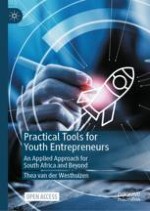Open Access 2024 | Open Access | Buch

Practical Tools for Youth Entrepreneurs
An Applied Approach for South Africa and Beyond
verfasst von: Thea van der Westhuizen
Verlag: Springer Nature Switzerland
Open Access 2024 | Open Access | Buch

verfasst von: Thea van der Westhuizen
Verlag: Springer Nature Switzerland
This open access book inspires young entrepreneurs to embark on the journey toward the future of work through actionable entrepreneurship, especially focusing on South Africa. Its insights and tools extend beyond borders, suiting the Global South and emerging markets.
Using systemic action learning, the author guides readers in developing both internal and external aspects of youth entrepreneurship.
Part One delves into the internal facets, exploring the interaction of entrepreneurial Heartset, Mindset & Handset that shape entrepreneurial behavior. The terms 'entrepreneurial heartset,' 'mindset,' and 'handset' encompass the neurological, thought-related, and behavioral dimensions of entrepreneurship — the Triple H.
The book illustrates external aspects through the SHAPE model (Shifting Hope Activating Potential Entrepreneurship) and YES network (Youth Entrepreneur Support). These models offer an ecosystem strategy for young entrepreneurs.
Part Two equips aspiring youth entrepreneurs with tools to overcome creativity barriers, generate business ideas, and nurture entrepreneurial traits. The SHAPE Four Quadrant Business Model Canvas and dropshipping for start-ups are among the implementable tools presented.
The book introduces original models for youth entrepreneur internal and external domains, offering substantive insights. The SHAPE Lab delivers comprehensive toolkits for youth entrepreneurship development.